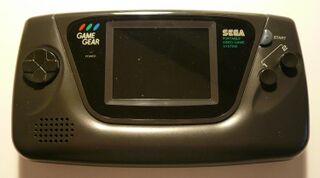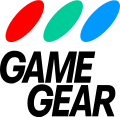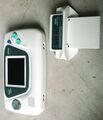Difference between revisions of "Sega Game Gear"
From Sega Retro
AllisonKidd (talk | contribs) |
AllisonKidd (talk | contribs) |
||
| Line 171: | Line 171: | ||
File:GameGear US PrintAdvert 2.jpg|US print advert 3 | File:GameGear US PrintAdvert 2.jpg|US print advert 3 | ||
File:GameGear UK PrintAdvert.jpg|UK print advert | File:GameGear UK PrintAdvert.jpg|UK print advert | ||
| + | File:GameGear_BR_PrintAdvert.jpg|BR print advert | ||
</gallery> | </gallery> | ||
Revision as of 00:10, 14 October 2014

| |||||
| Sega Game Gear | |||||
|---|---|---|---|---|---|
| Manufacturer: Sega | |||||
|
The Sega Game Gear (セガゲームギア) is a handheld video game console developed by Sega and released in late 1990 as a response to Nintendo's Game Boy handheld . It is a full colour console and was Sega's first attempt to compete in the handheld games market (the second being the Sega Nomad — a handheld Sega Mega Drive). In South Korea it is known as the Handy Gam*Boy (핸디겜보이).
Hardware
The Sega Game Gear is a "portable" device which was designed to address problems with Nintendo's Game Boy. It is held lengthwise at the sides (preventing the cramping of hands which plagued Nintendo's system) and has a backlit, colour LCD screen, allowing for clearer and more vibrant visuals than its main rival.
Similarly to the Sega Mega Drive, which at the time was Sega's main focus in the home console market, the Sega Game Gear is derived from the earlier Sega Master System. Unlike the Mega Drive, however, the Game Gear is largely identical to the Master System, the major difference being a VDP capable of displaying palettes consisting of a wider variety of colors, and the playback of stereo sound. Game Gear games traditionally run at a smaller resolution too, although with a screen built similarily to televisions of the era, the Game Gear is fully capable of playing games in higher resolutions.
Like the Master System, the Game Gear features a D-Pad and two buttons, ![]() and
and ![]() , but also adds a third, START . This is one button short of a Game Boy.
, but also adds a third, START . This is one button short of a Game Boy.
Unfortunately, due to technical limiations of the era, the Game Gear demands six AA batteries to be played on the go, of which the fluorescent backlight on the LCD screen will eat through in three to five hours (though a battery pack provides longer playtime). Furthermore, the system gives off more heat than the Game Boy, often leading to "sweaty palms" after prolonged use. The system was also considered not to be very "portable" - it's bulky size means it does not fit in many pockets, and the power-draining backlight of the LCD screen (which cannot be turned off) meant Game Gears were unusable after a short period of time. An AC adaptor can be plugged into the system so that it runs off the mains, but this was not considered practical for consumers of the day.
Game Gears were also manufactured at a time where capacitor problems were rampant across the electronics industry. As a result, screen and audio failures are common, and fixes are not always simple.
Models
- Main article: Sega Game Gear Models
Coloured Game Gears
Japan saw four coloured Game Gear models which did not see a release in the west - Blue, Red, Yellow and White. Only 10,000 white units were manufactured, and weren't available in stores. Instead, they were often given to developers or those directly associated with Sega. White units also came with a white TV Tuner and a white carrying case with enough space for the console, TV Tuner, AC adaptor and six AA batteries.
Game Gear development hardware
This, along with a TV-out modified Game Gear, consists of two cards to plug into a PC, an In-Circuit Emulator, a 5.25" floppy (presumably containing an assembler) and a large circuit board with composite video out.
Coca-Cola Game Gear
This was a limited-edition Japan-only release of the Game Gear as part of a promotion between Sega and Coca-Cola. It is exactly the same as a standard Game Gear console, save from a deep red color instead of the standard black. It was released with a similarly limited-edition game named 'Coca-Cola Kid'. An example of this unit is on display at the Coca-Cola museum in Atlanta.
In 2005, Coca-Cola released another limited edition handheld, the Coca-Cola Edition of the PlayStation Portable.
MKR Game Gear/Kids Gear
Another Japanese Game Gear variant is Magic Knight Rayearth GG, which sported a red color, and featured the Rayearth logo. Another variant is the so-called 'Kids Gear', released in 1996. This variant is again a standard Game Gear, only renamed and featuring a large Virtua Fighter 2 image fascia, which reflected the pack-in title (Virtua Fighter 2).
Handy Gam*Boy
A South Korean variant, distributed by Samsung in 1991.
Majesco Game Gear
The Majesco Game Gear is a model of Game Gear designed by Majesco. The casing is the same as the original Game Gear but the Game Gear logo was colored white. It is also incompatible with the first version of the Master Gear Converter and the Sega Game Gear TV Tuner.
Technical Specifications
- Main Processor: Zilog Z80 (8-bit)
- Processor Speed: 3.579545 MHz (same as NTSC colorburst)
- Resolution: 160 x 144 pixels
- Colors Available: 4,096
- Colors on screen: 32
- Maximum Sprites: 64
- Sprite Size: 8x8
- Screen Size: 3.2 Inches
- Audio: 4-channel tone generator composed of three square waves and one white noise channel.
- RAM: 24 KB
History
Development
Development on the Sega Game Gear began in 1989, with the codename Mercury. At the time, Nintendo's Game Boy was proving to be a huge success, despite its awkward shape and four shades of murky green/yellow. Sega felt that consumers may buy a handheld that fixed these problems, and so the Game Gear was born. It was originally announced at the Tokyo Toy Fair on the 7th June 1990.
Release
Japan
The Game Gear was first released in Japan on October 6, 1990 with launch titles Columns (bundled with the unit), Super Monaco GP, and Pengo. Japanese consumers were not interested in the handheld, and early units suffered from several hardware faults.
Japan was the only region to receive coloured systems (with one exception). Initial units were black, much like the rest of the world, but later, yellow, blue, red and white units were released, as well as several special versions tied to game releases.
North America
North America got the Game Gear in 1991. Sega of America advertised the Game Gear throughout its lifetime through a television advertising campaign involving amusing and bizarre spots, some directly attacking the Game Boy for its limited colour palette.
The Game Gear also went against other color handhelds, including the Atari Lynx and NEC TurboExpress. Though the Game Gear never topped the Game Boy, it did manage second place with its competitive price. Many of the Game Gear's flaws in regards to screens and battery life also applied to the Lynx and TurboExpress, the latter, being a TurboGrafx-16 in handheld form, was also incredibly expensive and poorly marketed.
Blue Game Gears were bundled with copies of World Series Baseball in this region. They are considerably rarer than the black models, and a darker shade than the Japanese blue models.
Majesco, who were given the rights to distribute older Sega consoles, re-released the Game Gear in 2000 with slightly improved specifications, including a better screen and longer battery life. Majesco Game Gears can be identified by their non-coloured logos and purple start buttons. They are incompatible with the TV Tuner.
Europe
Though a reasonably popular handheld in Europe, the Game Gear again played second best to the Game Boy, making it the first Sega console in that region to make less money than Nintendo.
Decline
While its hardware was superior to the Game Boy and was its most successful and longest lasting competitor, a combination of poor design choices and poor third-party support led to the Game Gear's eventual decline and discontinuation in 1997.
As with later consoles, third-party support for the Game Gear was in short supply. However, due to the hardware similarities, many early Game Gear games were modifications of Sega Master System games made to take advantage of the larger palette capabilities and smaller screen size. This meant many companies could convert their Master System lineup in to Game Gear titles fairly easily (and vice versa), but this only applied to companies supporting Europe, as by the time the Game Gear was released, the Master System had been discontinued in Japan and North America.
Approximately 390 Game Gear games were produced, with 11 million Game Gear units sold worldwide.
Legacy
After the Game Gear's discontinuation, Sega did not attempt to re-enter the handheld console market, instead choosing to become a third-party developer for other handhelds. Sega of America immediately moved to supporting Tiger Electronics's Game.com and R-Zone units, and by the end of the decade Sega of Japan backed the Neo Geo Pocket Color and licensed games to Bandai for the WonderSwan and to Media Factory for Nintendo's Game Boy Color. By the end of 2000 Sega had become a licensed third-party developer for Nintendo's handhelds, releasing Chu Chu Rocket! as a launch title for the Game Boy Advance.
Game Gear games are offered in the Nintendo 3DS's Virtual Console service.
Games
- See List of Game Gear games for a complete list.
Launch Titles
Japan
North America
- Castle of Illusion Starring Mickey Mouse
- Columns
- G-Loc: Air Battle
- Psychic World
- Revenge of Drancon
- Super Monaco GP
Europe
- Castle of Illusion Starring Mickey Mouse
- Columns
- Dragon Crystal
- G-Loc: Air Battle
- Psychic World
- Super Monaco GP
- Wonder Boy
Brazil
Gallery
JP model (Coca Cola Kid edition (Model #3210CR))
JP model (Magic Knight Rayearth edition (Model #HGG-3210 RAY))
JP model (Virtua Fighter Mini edition)
Promotional Material
- GameGear US PrintAdvert 3.jpg
US print advert
- GameGear US PrintAdvert.jpg
US print advert 2
- GameGear US PrintAdvert 2.jpg
US print advert 3
- GameGear UK PrintAdvert.jpg
UK print advert
- GameGear BR PrintAdvert.jpg
BR print advert
External links
- Console Database - Sega Game Gear info and FAQs
- SMS Power - Technical information and more on the Game Gear and its bigger brother, the Master System
| Sega Home Video Game Systems | ||||||||||||||||||||||||||||
| 83 | 84 | 85 | 86 | 87 | 88 | 89 | 90 | 91 | 92 | 93 | 94 | 95 | 96 | 97 | 98 | 99 | 00 | 01 | 02 | 03 | 04 | 05 | 06 | 07 | 08 | 09 | 10 | 11 |
|---|---|---|---|---|---|---|---|---|---|---|---|---|---|---|---|---|---|---|---|---|---|---|---|---|---|---|---|---|
| SG-1000 | SG-1000 II | Mega Drive | Mega Drive II | |||||||||||||||||||||||||
| SC-3000 | Mega-CD | Mega-CD II | Genesis 3 | |||||||||||||||||||||||||
| Sega Mark III | 32X | Dreamcast | ||||||||||||||||||||||||||
| Master System | Master System II | |||||||||||||||||||||||||||
| AI Computer | Game Gear | |||||||||||||||||||||||||||
| Saturn | ||||||||||||||||||||||||||||
| Pico | Beena | |||||||||||||||||||||||||||
| Sega Game Gear | |
| Topics | Sega Game Gear | History | Magazine articles | Promotional material | Merchandise |
|---|---|
| Hardware | Japan | North America | Western Europe | Eastern Europe | Asia | South America | Australasia | Africa Wide Gear | Fun Play 20-in-1 |
| Add-ons | Pro Action Replay | Game Genie | X-Terminator | Master Gear Converter (Gear Master | Nuby Converter) | Stereo FM Tuner | TV Tuner |
| Cases | Carry-All | Deluxe Carry-All Case | Gear Bag | Holster Case | Standard Carrying Case | Soft Case | Third Party (Play & Carry Case) |
| Accessories | A/V Cable | Battery Pack | Car Adaptor | Car Antenna | Cleaning Gear | Gear-to-Gear Cable | PowerBack (Third Party) | Screen Magnifier (Wide Gear | Super Wide Gear | Third-Party) |
| Development Tools | Sega Game Gear Development Board |












